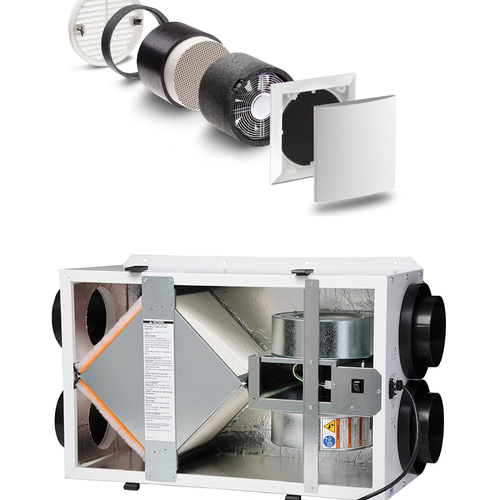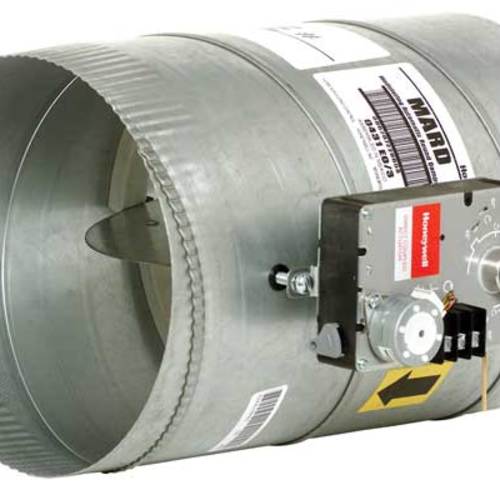Image Credit: Alex Wilson
One of the features in our new house that I’m most excited about barely raises an eyebrow with some of our visitors: the ventilation system. I believe we have the highest-efficiency heat-recovery ventilator (HRV) on the market — or at least it’s right up there near the top.
I’ll describe this Zehnder HRV and its impressive specifications and features — but not until next week. This week I’ll provide a little background on ventilation.
Why ventilate?
For centuries homes weren’t ventilated, and they did all right, didn’t they? Why do we need to go to all this effort (and often considerable expense) to ventilate houses today?
There are several reasons that ventilation is more important today than it was long ago. Most importantly, houses 100 years ago were really leaky. Usually they didn’t have insulation in the walls, so fresh air could pretty easily enter through all the gaps, cracks, and holes in the building envelope.
Also, the building materials used 100 years ago were mostly natural products that didn’t result in significant offgassing of volatile organic compounds (VOCs), formaldehyde, flame retardants, and other chemicals that are so prevalent in today’s building materials, furnishings, and belongings.
Ventilation options
Ventilation can take many different forms. Very generally, systems can be categorized into about a half-dozen generic types:
No ventilation. This is almost certainly the most common option in American homes. There is no mechanical system to remove stale indoor air (and moisture) or bring in fresh outside air. In the distant past, when buildings weren’t insulated, this strategy worked reasonably well — relying on the natural leakiness of the house.
It’s worth noting, though, that even a leaky house doesn’t ensure good ventilation. For this strategy to work there has to be either a breeze outside or a significant difference in temperature between outdoor and indoors. Either of these conditions creates a pressure difference between indoors and out, driving that ventilation. On calm days in the spring and summer, there might be very little air exchange even in a really leaky house.
Natural ventilation. In this rather uncommon strategy, specific design features are incorporated to bring in fresh air and get rid of stale air. One approach is to create a solar chimney in which air is heated by the sun, becomes more buoyant, and rises up and out through vents near the top of the building; this lowers the pressure in the house, which draws fresh air in through specially placed inlet ports. The rest of this blog will focus on mechanical ventilation.
Exhaust-only mechanical ventilation. This is a relatively common strategy in which small exhaust fans, usually in bathrooms, operate either continuously or intermittently to exhaust stale air and moisture generated in those rooms. This strategy creates a modest negative pressure in the house, and that pulls in fresh air either through cracks and other air-leakage sites or through strategically placed intentional make-up air inlets. An advantage of this strategy is simplicity and low cost. A disadvantage is that the negative pressure can pull in radon and other soil gases that we don’t want in houses.
Supply-only ventilation. As the name implies, a fan brings in fresh air, and stale air escapes through cracks and air-leakage sites in the house. The air supply may be delivered to one location, dispersed through ducts, or supplied to the ducted distribution system of a forced-air heating system for dispersal. A supply-only ventilation system pressurizes a house, which can be a good thing in keeping radon and other contaminants from entering the house, but it risks forcing moisture-laden air into wall and ceiling cavities where condensation and moisture problems can occur.
Balanced ventilation. Much better ventilation is provided through a balanced system in which separate fans drive both inlet and exhaust airflow. This allows us to control where the fresh air comes from, where that fresh air is delivered, and from where exhaust air is drawn. Balanced ventilation systems can be either point-source or ducted. With ducted systems, it makes sense to deliver fresh air to spaces that are most lived in (living room, bedrooms, etc.) and exhaust indoor air from places where moisture or pollutants are generated (bathrooms, kitchen, hobby room).
Balanced ventilation with heat recovery. If there are separate fans to introduce fresh air and exhaust indoor air, it makes a lot of sense to locate these fans together and include an air-to-air heat exchanger so that the outgoing house air will precondition the incoming outdoor air. This air-to-air heat exchanger — more commonly referred to today as a heat-recovery ventilator or HRV — is the way to go in colder climates. A slightly different version, known as an energy-recovery ventilator (ERV), is similar but transfers moisture as well as heat from one airstream to the other, keeping more of the desirable humidity in the house in the winter and reducing the amount of humidity introduced from outdoors in the summer.
Tight homes need mechanical ventilation
I’ll focus more on HRVs in next week’s blog, especially our new high-efficiency Zehnder system. Following that I’ll address why commissioning an HRV is so important and how that’s done — or at least how it was done with our system.
I’m a firm believer that all homes should have mechanical ventilation. With better-insulated, tighter homes, that ventilation is all the more important. But even in a very leaky house, one can’t count on bringing in much fresh air or calm days in the spring and fall when there isn’t a pressure differential across the building envelope.
If budgets allow, going with balanced ventilation is strongly recommended, and if you’re doing that in a relatively cold climate, like ours, then providing heat recovery is a no-brainer. Mechanical ventilation always takes energy; with heat recovery the energy penalty of fresh air is minimized.
Alex is founder of BuildingGreen, Inc. and executive editor of Environmental Building News. In 2012 he founded the Resilient Design Institute. To keep up with Alex’s latest articles and musings, you can sign up for his Twitter feed.
Weekly Newsletter
Get building science and energy efficiency advice, plus special offers, in your inbox.















4 Comments
Wrong fix for wrong fix for wrong fix....
Fires... OK.. add fire retardant add time... oops... fire retardants are bad
next....
add ventilation... to remove the last bad idea... of adding fire retardants.
The only added "value" is added economy... each step creates opportunities to "work" and receive compensation "income" " make a living...
while all the long... costing the homeowner... to deal with what was costing the homeowner... which was costing the homeowner... endless.
Nothing simple. Everyday we get more reliant on each other and less simple.
This simple guy likes simple though I am no better at simple than the worst.
PGH... natural building... opening windows... not worrying about Radon when I still have not found a single person attacked by radon... but oh do all the learned and educated amongst us WORRY about it. I say the worry is more harmful.
KISS keep it simple. Wish RR stayed here to defend that idea without the flame wars and insults.
Alex... your home is quite the model and I do like it even though I prefer simple. You should publish the plans with complete details and list of materials. That is the missing half of all the posts and blogs and blah here and all over the internet.
why so expensive?
I notice that this HRV units cost upwards of $1500. Are the manufacturers trying to gouge people? The units are much less complex than a furnace and cost almost as much. Where is the expense in a heat exchanger and fans? Probably would see more ventilation if the machine only did not cost so much.
How much fresh air?
At a time when we are asked to conserve energy – are these things a good idea? You can open and close a window without using any power or incurring any cost.
Keeping in mind that we breath in between 0.211 cubic feet per minute when sitting or doing simple chores, to 21 cubic when doing hard energetic exercise, is there some way of controlling this thing, to relate its fresh air input and power usage to the number of people in the home at the time and their fresh air requirements?
How sophisticated are its controls? What is its lowest cubic foot intake per minute?
Response to Roger Anthony
Roger,
Q. "How much fresh air?"
A. Here are links to two articles that address your question:
Ventilation Rates and Human Health
How Much Fresh Air Does Your Home Need?
Q. "Is there some way of controlling this thing?"
A. All HRVs include controls that allow the user to determine the home's ventilation rate. If you want a lower ventilation rate than is provided by the slowest fan setting on your HRV, you can control the appliance with a timer so that you ventilate (for example) for 20 minutes per hour.
Log in or create an account to post a comment.
Sign up Log in